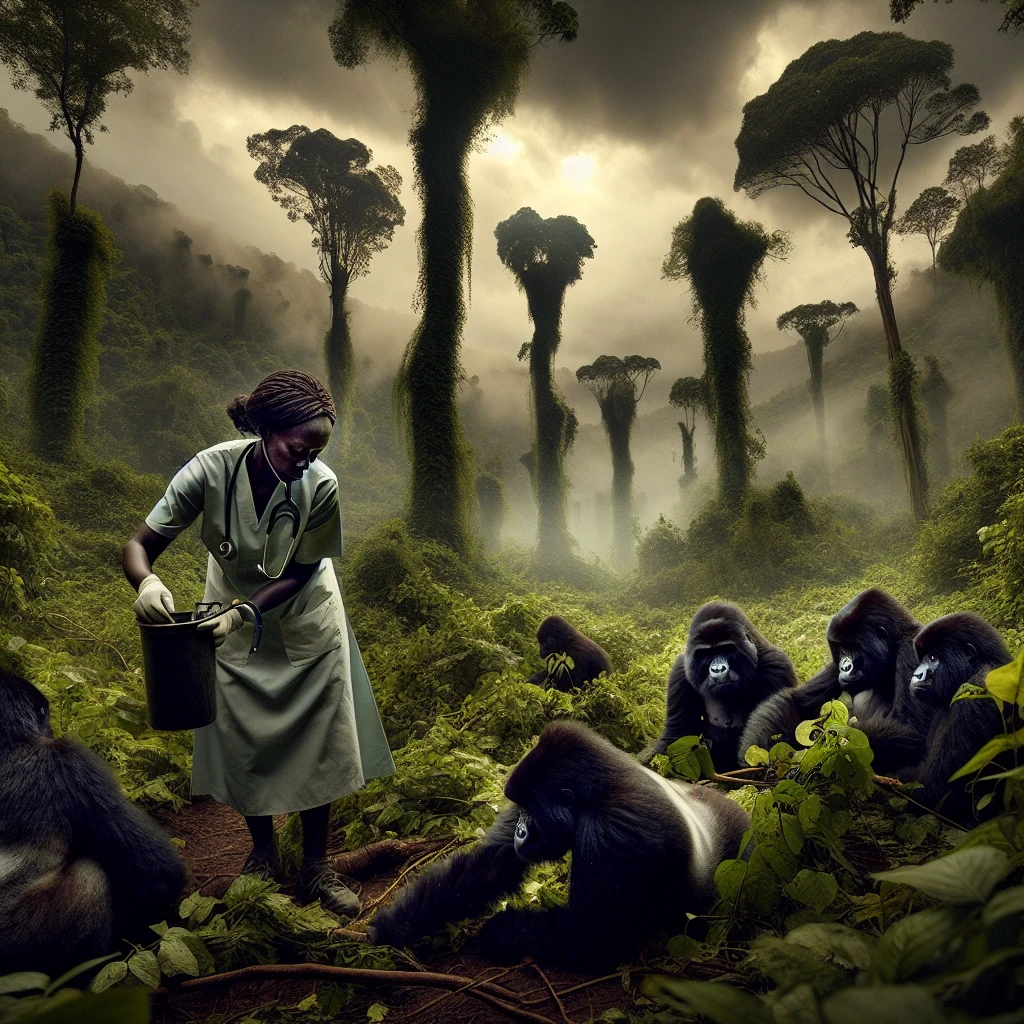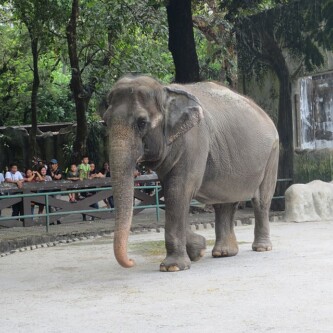Uganda’s mountain gorillas are in danger because of climate change. Dr. Gladys Kalema-Zikusoka, a wildlife vet and founder of Conservation Through Public Health, is working hard to protect these endangered animals. Her organization wants to help humans, gorillas, and other wildlife live together peacefully and stay healthy.
Dr. Kalema-Zikusoka has done a great job in increasing the number of mountain gorillas from 300 to about 500. Because of this, they have been moved from the critically endangered list to the endangered list. She has been working for over 30 years and has made a big difference in saving these amazing creatures.
Dr. Kalema-Zikusoka has been recognized for her amazing work and has been included in the BBC 100 Women list. This list shows women who are making a difference in different areas, like protecting wildlife from climate change. You can read more about her and other women who are working on this important cause on the BBC website.
If you want to know more about Dr. Kalema-Zikusoka and other inspiring women, you can follow BBC 100 Women on Facebook and Instagram. You can also join the conversation using the hashtag #BBC100Women. The video that goes with this article, made by Rebecca Thorn and filmed by Godfrey Badebye, gives more information about the efforts to save Uganda’s gorillas from climate change.
In conclusion, Dr. Gladys Kalema-Zikusoka and Conservation Through Public Health are doing important work to protect Uganda’s mountain gorillas from the effects of climate change. Because of her dedication and knowledge, she has been able to increase their numbers and improve their conservation status. Her inclusion in the BBC 100 Women list shows how much she has done for wildlife conservation.
Original news source: Climate change: Saving Uganda’s mountain gorillas (BBC)
Listen
Slow
Normal
Fast
Group or Classroom Activities
Warm-up Activities:
– Charades
Instructions: Divide the class into small groups. Give each group a list of words related to the article (e.g. gorilla, conservation, climate change, wildlife, vet). One person from each group will act out the word without speaking, while the others try to guess the word. The group with the most correct guesses wins.
– News Summary
Instructions: Ask students to read the article individually, and then summarize the main points in their own words. Afterward, divide the class into pairs and have them share their summaries with each other. Encourage discussion and ask follow-up questions to check comprehension.
– Opinion Poll
Instructions: Divide the class into small groups. Give each group a statement related to the article (e.g. “Climate change is the biggest threat to wildlife conservation”). Have each group discuss the statement and come up with their own opinions. Then, conduct a class poll by asking each group to share their opinions and provide reasons for their choices. Facilitate a discussion to compare and contrast different viewpoints.
– Vocabulary Pictionary
Instructions: Create a list of vocabulary words from the article (e.g. endangered, conservation, wildlife, dedication). Divide the class into pairs. One student from each pair will choose a word and draw a picture representing that word, while the other student tries to guess the word. Students can take turns drawing and guessing. This activity helps reinforce vocabulary and understanding of the article.
– Future Predictions
Instructions: In small groups, have students discuss and make predictions about the future of Uganda’s mountain gorillas and wildlife conservation in the face of climate change. Encourage them to consider the challenges and potential solutions. Each group can present their predictions to the class, and a class discussion can follow to share ideas and insights.
Comprehension Questions:
1. Who is Dr. Gladys Kalema-Zikusoka and what is her organization called?
2. What is the main threat to Uganda’s mountain gorillas?
3. How has Dr. Kalema-Zikusoka helped increase the number of mountain gorillas?
4. What is the difference between the critically endangered list and the endangered list?
5. Why has Dr. Kalema-Zikusoka been recognized and included in the BBC 100 Women list?
6. Where can you find more information about Dr. Kalema-Zikusoka and other inspiring women?
7. What is the purpose of the video made by Rebecca Thorn and filmed by Godfrey Badebye?
8. What does Dr. Kalema-Zikusoka’s inclusion in the BBC 100 Women list show about her work in wildlife conservation?
Go to answers ⇩
Listen and Fill in the Gaps:
Uganda’s (1)______ gorillas are in (2)______ because of climate change. Dr. Gladys Kalema-Zikusoka, a wildlife vet and (3)______ of Conservation Through Public Health, is working hard to protect these endangered animals. Her organization wants to help humans, gorillas, and other wildlife live together peacefully and stay healthy.
Dr. Kalema-Zikusoka has done a great job in increasing the (4)______ of mountain gorillas from 300 to about 500. Because of this, they have been moved from the critically endangered list to the endangered list. She has been working for over 30 years and has made a big difference in saving these (5)______ creatures.
Dr. Kalema-Zikusoka has been recognized for her amazing work and has been included in the BBC 100 Women list. This list shows women who are making a difference in different (6)______, like protecting (7)______ from (8)______ change. You can read more about her and other (9)______ who are working on this important cause on the BBC website.
If you want to know more about Dr. Kalema-Zikusoka and other inspiring women, you can follow BBC 100 Women on Facebook and Instagram. You can also join the (10)______ using the hashtag #BBC100Women. The video that goes with this article, made by Rebecca (11)______ and filmed by Godfrey Badebye, gives more information about the (12)______ to save Uganda’s gorillas from climate change.
In (13)______, Dr. Gladys Kalema-Zikusoka and Conservation Through Public Health are doing important work to protect Uganda’s mountain gorillas from the effects of climate change. Because of her (14)______ and knowledge, she has been able to increase their numbers and improve their conservation (15)______. Her inclusion in the BBC 100 Women list (16)______ how much she has done for wildlife conservation.
Go to answers ⇩
Discussion Questions:
Students can ask a partner these questions, or discuss them as a group.
1. What is climate change and how does it affect animals like mountain gorillas?
2. How do you think humans and wildlife can live together peacefully?
3. Do you think it’s important to protect endangered animals? Why or why not?
4. How would you feel if you saw a mountain gorilla in real life? Why?
5. What do you think are some challenges that Dr. Gladys Kalema-Zikusoka faces in her work?
6. Why do you think it’s important to recognize and celebrate women like Dr. Kalema-Zikusoka for their work?
7. Do you think social media can help raise awareness about wildlife conservation? Why or why not?
8. What other ways can people help protect endangered animals?
9. How do you think climate change affects other wildlife besides mountain gorillas?
10. Have you ever seen any endangered animals in real life? How did it make you feel?
11. Do you think it’s possible to completely stop climate change? Why or why not?
12. How do you think Dr. Kalema-Zikusoka’s work has made a difference in the world?
13. What other endangered animals do you know about? Why do you think they are endangered?
14. Do you think governments should do more to protect endangered animals? Why or why not?
15. What can individuals do to contribute to wildlife conservation efforts?
Individual Activities
Vocabulary Meanings:
Match each word to its meaning.
Words:
1. Uganda
2. gorillas
3. climate change
4. wildlife
5. endangered
6. organization
7. conservation
8. dedication
Meanings:
(a) At risk of becoming extinct
(b) Animals that live in their natural habitats
(c) The long-term change in weather patterns
(d) Large, powerful animals that live in the forest
(e) The commitment and hard work towards a cause
(f) The protection and preservation of natural resources
(g) A country in Africa known for its wildlife
(h) A group of people working together for a common goal
Go to answers ⇩
Multiple Choice Questions:
1. What is Dr. Gladys Kalema-Zikusoka’s profession?
(a) Climate scientist
(b) Environmental activist
(c) Wildlife vet
(d) Conservation biologist
2. What is the name of Dr. Kalema-Zikusoka’s organization?
(a) Gorilla Protection Society
(b) Wildlife Conservation Alliance
(c) Climate Change Warriors
(d) Conservation Through Public Health
3. How many mountain gorillas are currently estimated to be in Uganda?
(a) About 300
(b) About 500
(c) About 1,000
(d) About 200
4. What list did the mountain gorillas move from?
(a) Critically endangered list
(b) Endangered list
(c) Extinct list
(d) Vulnerable list
5. Why has Dr. Kalema-Zikusoka been recognized by the BBC?
(a) For her work in protecting wildlife from climate change
(b) For her efforts in promoting women’s rights
(c) For her research on mountain gorillas
(d) For her work as a wildlife vet
6. Where can you find more information about Dr. Kalema-Zikusoka and other inspiring women?
(a) National Geographic magazine
(b) Conservation Through Public Health website
(c) BBC website
(d) Wildlife Conservation Society blog
7. What social media platforms can you follow BBC 100 Women on?
(a) Twitter and Snapchat
(b) Facebook and Instagram
(c) TikTok and Pinterest
(d) LinkedIn and YouTube
8. Who made the video about the efforts to save Uganda’s gorillas from climate change?
(a) Dr. Gladys Kalema-Zikusoka
(b) Godfrey Badebye
(c) BBC 100 Women
(d) Rebecca Thorn
Go to answers ⇩
True or False Questions:
1. Uganda’s mountain gorillas are at risk due to climate change.
2. Dr. Gladys Kalema-Zikusoka is not a wildlife vet and founder of Conservation Through Public Health.
3. Dr. Kalema-Zikusoka has been recognized for her work and is included in the BBC 100 Women list.
4. The BBC 100 Women list showcases women making a difference in various areas, including protecting wildlife from climate change.
5. As a result, mountain gorillas have been moved from the endangered list to the critically endangered list.
6. Her organization aims to promote conflict and poor health for humans, gorillas, and other wildlife.
7. Dr. Kalema-Zikusoka’s efforts have helped increase the number of mountain gorillas from 300 to about 500.
8. To learn less about Dr. Kalema-Zikusoka and other uninspiring women, you can unfollow BBC 100 Women on Facebook and Instagram.
Go to answers ⇩
Write a Summary:
Write a summary of this news article in two sentences.
Check your writing now with the best free AI for English writing!
Writing Questions:
Answer the following questions. Write as much as you can for each answer.
Check your answers with our free English writing assistant!
1. Who is Dr. Gladys Kalema-Zikusoka and what is her organization trying to do?
2. How has Dr. Kalema-Zikusoka helped increase the number of mountain gorillas?
3. What recognition has Dr. Kalema-Zikusoka received for her work?
4. Where can you find more information about Dr. Kalema-Zikusoka and other inspiring women?
5. Why is Dr. Kalema-Zikusoka’s work important for protecting Uganda’s mountain gorillas?
Answers
Comprehension Question Answers:
1. Who is Dr. Gladys Kalema-Zikusoka and what is her organization called?
Dr. Gladys Kalema-Zikusoka is a wildlife vet and the founder of Conservation Through Public Health.
2. What is the main threat to Uganda’s mountain gorillas?
The main threat to Uganda’s mountain gorillas is climate change.
3. How has Dr. Kalema-Zikusoka helped increase the number of mountain gorillas?
Dr. Kalema-Zikusoka has helped increase the number of mountain gorillas by working for over 30 years to protect and conserve them.
4. What is the difference between the critically endangered list and the endangered list?
The critically endangered list is a more severe classification, meaning that the species is at a higher risk of extinction. The endangered list means that the species is still at risk, but not as critically.
5. Why has Dr. Kalema-Zikusoka been recognized and included in the BBC 100 Women list?
Dr. Kalema-Zikusoka has been recognized and included in the BBC 100 Women list because of her important work in protecting wildlife from climate change.
6. Where can you find more information about Dr. Kalema-Zikusoka and other inspiring women?
You can find more information about Dr. Kalema-Zikusoka and other inspiring women on the BBC 100 Women website, as well as on their Facebook and Instagram pages.
7. What is the purpose of the video made by Rebecca Thorn and filmed by Godfrey Badebye?
The purpose of the video is to provide more information about the efforts to save Uganda’s gorillas from climate change.
8. What does Dr. Kalema-Zikusoka’s inclusion in the BBC 100 Women list show about her work in wildlife conservation?
Dr. Kalema-Zikusoka’s inclusion in the BBC 100 Women list shows that her work in wildlife conservation is recognized and valued, and that she has made a significant impact in protecting Uganda’s mountain gorillas.
Go back to questions ⇧
Listen and Fill in the Gaps Answers:
(1) mountain
(2) danger
(3) founder
(4) number
(5) amazing
(6) areas
(7) wildlife
(8) climate
(9) women
(10) conversation
(11) Thorn
(12) efforts
(13) conclusion
(14) dedication
(15) status
(16) shows
Go back to questions ⇧
Vocabulary Meanings Answers:
1. Uganda
Answer: (g) A country in Africa known for its wildlife
2. gorillas
Answer: (d) Large, powerful animals that live in the forest
3. climate change
Answer: (c) The long-term change in weather patterns
4. wildlife
Answer: (b) Animals that live in their natural habitats
5. endangered
Answer: (a) At risk of becoming extinct
6. organization
Answer: (h) A group of people working together for a common goal
7. conservation
Answer: (f) The protection and preservation of natural resources
8. dedication
Answer: (e) The commitment and hard work towards a cause
Go back to questions ⇧
Multiple Choice Answers:
1. What is Dr. Gladys Kalema-Zikusoka’s profession?
Answer: (c) Wildlife vet
2. What is the name of Dr. Kalema-Zikusoka’s organization?
Answer: (d) Conservation Through Public Health
3. How many mountain gorillas are currently estimated to be in Uganda?
Answer: (b) About 500
4. What list did the mountain gorillas move from?
Answer: (a) Critically endangered list
5. Why has Dr. Kalema-Zikusoka been recognized by the BBC?
Answer: (a) For her work in protecting wildlife from climate change
6. Where can you find more information about Dr. Kalema-Zikusoka and other inspiring women?
Answer: (c) BBC website
7. What social media platforms can you follow BBC 100 Women on?
Answer: (b) Facebook and Instagram
8. Who made the video about the efforts to save Uganda’s gorillas from climate change?
Answer: (d) Rebecca Thorn
Go back to questions ⇧
True or False Answers:
1. Uganda’s mountain gorillas are at risk due to climate change. (Answer: True)
2. Dr. Gladys Kalema-Zikusoka is not a wildlife vet and founder of Conservation Through Public Health. (Answer: False)
3. Dr. Kalema-Zikusoka has been recognized for her work and is included in the BBC 100 Women list. (Answer: True)
4. The BBC 100 Women list showcases women making a difference in various areas, including protecting wildlife from climate change. (Answer: True)
5. As a result, mountain gorillas have been moved from the endangered list to the critically endangered list. (Answer: False)
6. Her organization aims to promote conflict and poor health for humans, gorillas, and other wildlife. (Answer: False)
7. Dr. Kalema-Zikusoka’s efforts have helped increase the number of mountain gorillas from 300 to about 500. (Answer: True)
8. To learn less about Dr. Kalema-Zikusoka and other uninspiring women, you can unfollow BBC 100 Women on Facebook and Instagram. (Answer: False)
Go back to questions ⇧













